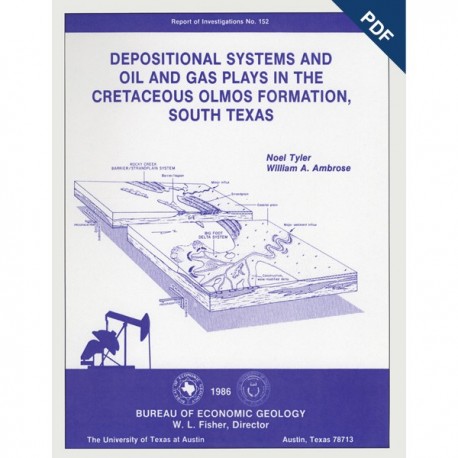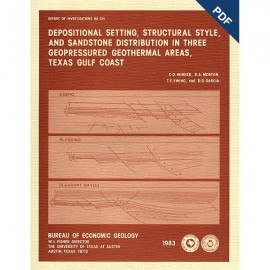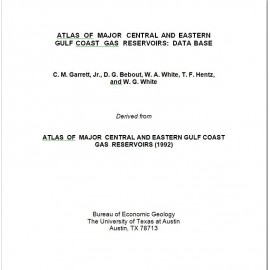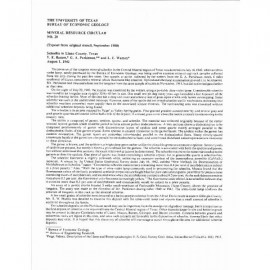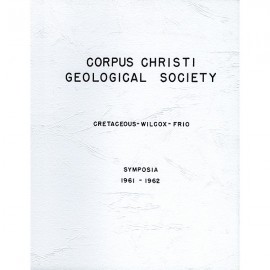Reports of Investigations
-
Books & Reports
- Reports of Investigations
- Guidebooks
- Udden Series
- Geological Circulars
- Down To Earth
- Atlases of Major Oil and Gas Reservoirs
- Texas Memorial Museum Publications
- Environmental Geologic Atlas of the Texas Coastal Zone
- Mineral Resource Circulars
- Other Reports
- Seminars and Workshops
- Handbooks
- Submerged Lands of Texas
- Symposia
- Annual Reports
- Open File Reports
-
Maps & Cross Sections
- Thematic Maps
- Miscellaneous Maps, Charts & Sections
- Geologic Atlas of Texas
- STATEMAP Project Maps
- Geologic Quadrangle Maps
- Cross Sections
- Highway Geology Map
- Energy and Mineral Resource Maps
- Shoreline Change and Other Posters
- Wilcox Group, East Texas, Geological / Hydrological Folios
- Bouguer Gravity Atlas of Texas
- River Basin Regional Studies
- Featured Maps
- Posters
- Teachers & the Public
-
Geological Society Publications
- Gulf Coast Association of Geological Societies
- Alabama Geological Society
- Austin Geological Society
- Corpus Christi Geological Society
- Houston Geological Society
- Lafayette Geological Society
- Mississippi Geological Society
- New Orleans Geological Society
- South Texas Geological Society
- GCS SEPM Publications
- Historic BEG & UT Series
Depositional Systems and Oil and Gas Plays in the...Olmos Formation, South Texas. Digital Download
RI0152D
A free, digital version of this publication can be found on: Texas ScholarWorks
To purchase a print version (if available): RI0152
RI0152D. Depositional Systems and Oil and Gas Plays in the Cretaceous Olmos Formation, South Texas, by Noel Tyler and W. A. Ambrose. 42 p., 33 figs., 7 tables, 1 plate, 1986. doi.org/10.23867/RI0152D. Downloadable PDF.
To purchase this publication in book format, please order RI0152.
ABSTRACT
The Upper Cretaceous Olmos Formation in South Texas continues to be an active exploration target 60 years after oil was first discovered in this clastic assemblage. The shallow, oil-bearing formation was deposited on a broad, wave-influenced shelf. Sand accumulated in two depocenters. Initial deposition took place in a western depocenter during an early phase of wave-dominated deltaic sedimentation. Deposition of the strike-elongate delta preceded two cycles of high-constructive deltaic deposition, during which time sediments prograded seaward over the Lower Cretaceous shelf edge. These three deltaic complexes together compose the Catarina delta system. The focus of sedimentation then shifted eastward to the Big Foot delta system, where again wave-dominated deltaic sedimentation was followed by two episodes of high-constructive but wave-modified delta formation. Sands not retained in the Big Foot delta system migrated alongshore to the west, where they formed a thick retrogradational coastal/interdeltaic complex, named the Rocky Creek barrier/strandplain system. Regional uplift with concomitant erosion removed much of the updip facies tracts of the Olmos. This truncated section was then unconformably covered by Escondido shelf mudstones, thereby creating conditions favorable for stratigraphic entrapment of hydrocarbons migrating updip from the deeper basin through permeable deltaic sandstones.
The resulting stratigraphic trap play is the most prolific of the seven oil and gas plays in the Olmos Formation. Six other plays produce oil and gas from a variety of structural traps, but most of the remaining oil production is from the Charlotte Fault Zone. Youthful shelf-edge gas, condensate, and oil plays are highly productive, and together with wildcat prospects further basinward offer the best potential for continued high-level production from this mature province.
Keywords: Maverick Basin, Olmos Formation, Cretaceous, Gulfian, deltas, barrier/strandplains, oil and gas, Charlotte Fault Zone
CONTENTS
ABSTRACT
INTRODUCTION
Structural framework
Stratigraphy and depositional systems
Objectives and methods
REGIONAL SEDIMENTARY PATTERNS OF THE OLMOS FORMATION
Western depocenter
Eastern depocenter
CATARINA DELTA SYSTEM
Deltaic unit A
Regional extent
Depositional environments
Deltaic unit B
Regional extent
Electric log response
Depositional environments
Deltaic unit C
Regional extent
Lithofacies
Electric log response
Depositional environments
ROCKY CREEK BARRIER/STRANDPLAIN SYSTEM
Shore-zone unit D
Regional extent
Lithofacies
Electric log response
Depositional environments
Shore-zone unit E
Regional extent
Lithofacies
Depositional environments
BIG FOOT DELTA SYSTEM
Deltaic unit F
Regional extent
Depositional environments
Deltaic unit G
Regional extent
Electric log response
Depositional environments
Deltaic unit H
Regional extent
Electric log response
Depositional environments
OLMOS DEPOSITIONAL HISTORY
OLMOS OIL AND GAS PLAYS
Updip stratigraphic traps
Charlotte Fault Zone
Updip structural traps
Volcanic mounds
Deltaic and shorezone sandstone structural traps
Downdip deltaic and shelf tight gas sandstones
Shelf-edge traps
CONCLUSIONS
Future exploration targets
ACKNOWLEDGMENTS
REFERENCES
FIGURES
1. Regional structure map of the Maverick Basin contoured on the' top of the Olmos Formation
2. Structural framework of the Maverick Basin
3. Schematic dip section through the Maverick Basin
4. Well control and location of type logs and stratigraphic dip and strike sections
5. lsopach map of the Olmos Formation
6. Net-sandstone map of the Olmos Formation
7. Type logs of the Olmos Formation from the eastern and western depocenters
8. Simplified stratigraphic strike section A-A'
9. Simplified stratigraphic dip section B-B' from the western depocenter
10. Simplified stratigraphic dip section C-C' from the eastern depocenter
11. Net-sandstone map, unit A
12. Net-sandstone map, unit B
13. Map showing distribution of SP log facies and interpretation of unit B
14. Percent sandstone map, unit C
15. Channel-mouth bar, distributary-channel, and abandoned-channel-fill deposits of unit C, Tesoro No. 3 Gates Ranch core
16. Crevasse splay sandstones interbedded with marsh and shallow-shelf (foundered delta) deposits of unit C, Tesoro No. 3 Gates Ranch core
17. Map showing distribution of SP log facies and interpretation of unit C
18. Net-sandstone map, unit D
19. Barrier and washover sandstones interbedded with shallow lagoon mudstones in unit D, Tesoro No. 2 Gates Ranch core
20. Map showing distribution of SP log facies and interpretation of unit D
21. Percent-sandstone map, unit E
22. Shallow-lagoon sediments truncated by a tidal-channel sandstone in unit E, Tesoro No. 2 Gates Ranch core
23. Net-sandstone map, unit F
24. Net-sandstone map, unit G
25. Net-sandstone map, unit H
26. Early to middle Olmos depositional model
27. Late Olmos depositional model
28. Morphology of sandstone units in the Olmos Formation
29. Discovery history of Olmos oil and gas fields
30. Olmos field size based on cumulative production to 1983
31. Oil and gas fields and major exploration and production plays, Olmos Formation
32. Cumulative oil and gas production from the seven Olmos plays
33. Map showing potential areas of unconformity-related stratigraphic traps
TABLES
1. Olmos plays ranked by cumulative total hydrocarbon production
2. Geologic, engineering, and production characteristics of the stratigraphic trap play
3. Geologic, engineering, and production characteristics of the Charlotte Fault Zone play
4. Geologic, engineering, and production characteristics of the updip structural trap play
5. Geologic, engineering, and production characteristics of a volcanic mound field as exemplified by the Elaine (Olmos) pool
6. Geologic, engineering, and production characteristics of the deltaic and shore-zone sandstone structural trap play
7. Geologic, engineering, and production characteristics of the Olmos downdip deltaic and shelf tight-gas sandstone play
Plate (in pocket of book): Stratigraphic cross sections, Olmos Formation.
A. Updip strike section
B. Western depocenter dip section
C. Eastern depocenter dip section
Citation
Tyler, Noel, and Ambrose, W. A., 1986, Depositional Systems and Oil and Gas Plays in the Cretaceous Olmos Formation, South Texas: The University of Texas at Austin, Bureau of Economic Geology, Report of Investigations No. 152, 42 p.
